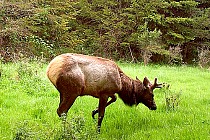The Oregon Department of Fish & Wildlife has confirmed 16 cases of hoof disease in Oregon elk since the first case was confirmed in early 2014. Veterinary staff are reminding hunters throughout Oregon to be on the lookout for limping elk that may have this debilitating disease.
Report any sightings to the ODFW’s elk hoof disease online reporting page.
Elk hoof disease is a bacterial infection that causes severe lameness in elk. Elk with the disease have deformed and overgrown or broken sloughed hooves and other hoof abnormalities related to the infection.
ODFW’s veterinary staff requests that hunters who harvest an elk with infected or overgrown hooves save all hooves and contact the ODFW Wildlife Health Laboratory (1-866-968-2600/Wildlife.Health@state.or.us) to arrange for collection.
Hoof disease does not affect the meat of elk harvested by hunters and poses no risk to human health. However, lame elk may be in poorer body condition and appear thin.
The online reporting page for elk hoof disease was launched during the fall of 2014 and is used to track observations of limping elk submitted by the public. Initial cases and reports were identified in counties bordering southwest Washington where the initial outbreak occurred. However, over the past year ODFW has documented other sporadic cases in northeastern Oregon.
“Observations reported by the public are critical in mapping where the disease currently exists and how the distribution is changing,” said Julia Burco, ODFW district wildlife veterinarian. “There is still a lot to learn about this new disease in Oregon and every new observation helps.”
The condition initially appeared in southwestern Washington elk herds between the late 1990s and early 2000s. A dramatic rise in reports of limping elk in 2007-2008 prompted an investigation into the underlying cause. In 2014, the bacteria known as treponemes were identified as a consistent organism associated with the deformed, overgrown, broken or sloughed hooves seen in affected elk. In some of southwest Washington’s elk herds, 20-90 percent of the animals are showing lameness.
Because of the known interchange between Oregon and Washington elk across the Columbia River, the disease was anticipated by ODFW staff. However, the wide distribution of sporadic cases across Oregon are difficult to understand and are being investigated further.
Oregon’s big game hunting seasons are underway now through the end of the year. Oregon’s first general rifle elk season, Cascade elk, opens Saturday, Oct. 15.










